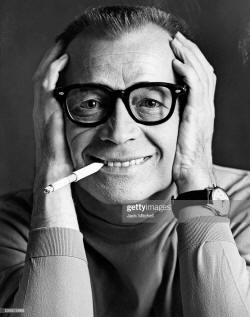

 Eugene Loring (August 2, 1911 – August 30, 1982) was an American dancer, choreographer, teacher, and administrator.[1]
An incomplete list of the
variously bisexual and homosexual men to be connected to
Lincoln Kirstein’s
work around mid-century – many of them suspiciously ‘international’
– would include the composers Aaron Copland,
Paul Bowles,
Virgil
Thomson, Marc Blitzstein, and
Samuel Barber; the artists and
designers Pavel Tchelitchev,
Paul Cadmus,
Jared French,
Eugene
Berman, Cecil Beaton, and
Christian Bérard; the choreographers
Jerome Robbins,
Eugene Loring,
Antony Tudor, and
Frederick Ashton;
and the literati who provided ideas, wrote essays and reviews, or were
simply enthusiasts, such as Carl Van Vechten,
Edwin Denby,
W. H.
Auden, Frank O’Hara,
Charles Henri Ford,
John Ashbery,
Parker Tyler,
Glenway Wescott, and
Monroe Wheeler. For these men, as much as
for Kirstein himself, queerness was not necessarily understood as a
prime and defining force, and the queer component of this creative
environment was only allowed to manifest itself under particular
constraints.
Eugene Loring (August 2, 1911 – August 30, 1982) was an American dancer, choreographer, teacher, and administrator.[1]
An incomplete list of the
variously bisexual and homosexual men to be connected to
Lincoln Kirstein’s
work around mid-century – many of them suspiciously ‘international’
– would include the composers Aaron Copland,
Paul Bowles,
Virgil
Thomson, Marc Blitzstein, and
Samuel Barber; the artists and
designers Pavel Tchelitchev,
Paul Cadmus,
Jared French,
Eugene
Berman, Cecil Beaton, and
Christian Bérard; the choreographers
Jerome Robbins,
Eugene Loring,
Antony Tudor, and
Frederick Ashton;
and the literati who provided ideas, wrote essays and reviews, or were
simply enthusiasts, such as Carl Van Vechten,
Edwin Denby,
W. H.
Auden, Frank O’Hara,
Charles Henri Ford,
John Ashbery,
Parker Tyler,
Glenway Wescott, and
Monroe Wheeler. For these men, as much as
for Kirstein himself, queerness was not necessarily understood as a
prime and defining force, and the queer component of this creative
environment was only allowed to manifest itself under particular
constraints.
Eugene Loring was born as Le Roy Kerpestein, the son of a saloon-keeper, grew up on a small island in the Milwaukee River in Wisconsin.[2] He took gymnastic lessons. His artistic education in Milwaukee was formative. Nine years of piano training developed his musical ability broadly into orchestration, and his work with the Wisconsin Players, particularly under the direction of the Russian Boris Glagolin, developed his strong theatrical sense and gave him an awareness of dance as a theatrical force. With savings from his job as a hardware-store manager, Loring went to New York City near the depth of the Great Depression in 1934, and was taken into George Balanchine's and Lincoln Kirstein's newly formed School of American Ballet. With the Russian Imperial training given by SAB, he danced with Balanchine's first American company, American Ballet, and even auditioned successfully for Michel Fokine. When Kirstein formed the specifically American choreographic training company Ballet Caravan in 1936, Loring and Lew Christensen (who together formed a little company, Dance Players, 1941–42) emerged as its outstanding products.[3]
Perhaps Kirstein’s intentions were forced with the temporary departure of Balanchine and the formation of a touring company in Ballet Caravan. In seeking to appeal to provincial audiences, Kirstein opted for a harder, more nationalistic ‘sell’. This element was often announced in the titles. With Ballet Caravan he produced Pocahontas (1936), with choreography by Lew Christenson to music by Elliott Carter, Jr.; Yankee Clipper (1937), with choreography by Eugene Loring to music by Paul Bowles; Filling Station (1938), with choreography again provided by Christenson, to music by Virgil Thomson; and Billy the Kid (1938), with Loring again as choreographer, and Aaron Copland as composer. Kirstein had an important say in the choice of topics, and he wrote the ‘book’ for all four ballets.
Within two years Loring choreographed and danced in Billy the Kid, which enjoys status as the first American ballet classic, with an unbroken history of production since. After choreographic residence at Bennington College, Vermont, where he made some works, Loring joined Ballet Theatre (now ABT) in 1939, where, in that company's first season, he choreographed and danced in his The Great American Goof, with libretto by William Saroyan.[4] Loring, who began dancing in his father's saloon, was at ease with all kinds of dance: national, classic, modern, theater or not. He choreographed the Broadway musicals Carmen Jones and Silk Stockings and had an extensive career in Hollywood, directing and choreographing for film and television. Dancers he worked with most frequently include Fred Astaire, Cyd Charisse, and James Mitchell. Some of Loring's most notable films include: Silk Stockings, Funny Face (both in 1957), Ziegfeld Follies, The Toast of New Orleans, Deep in My Heart, Meet Me in Las Vegas. Resettled in Los Angeles in 1943 on contract with MGM (Loring had a feature role in National Velvet even before he choreographed for them), he turned his attention to regularizing and applying his principles of versatile "Freestyle" professional dance education, including (from 1955) his own dance notation, Kineseography.[5] Loring operated the commercially successful American School of Dance in Hollywood along those principles, and from 1965 developed them in a university educational setting, on invitation by Dean Clayton Garrison to chair the Department of Dance within the School of Fine Arts of the newly formed University of California, Irvine. Loring retired from UCI in 1981, returned to New York State but died a year later, aged seventy-one.[6]
My published books: